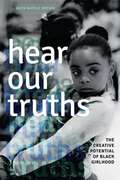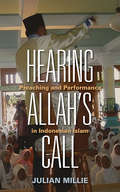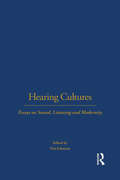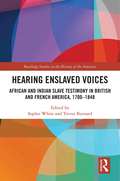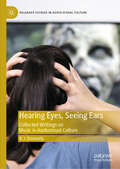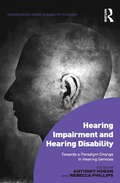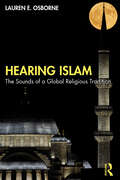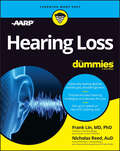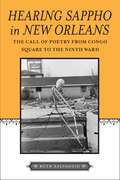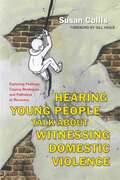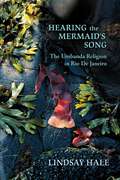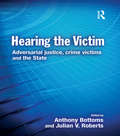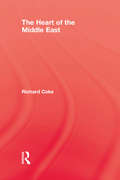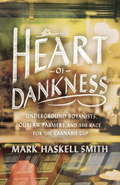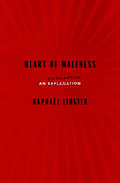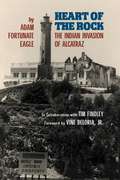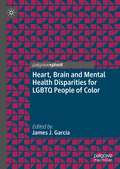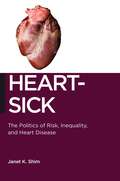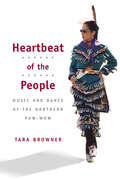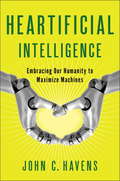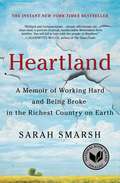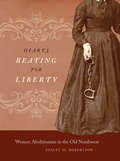- Table View
- List View
Hear Our Truths: The Creative Potential of Black Girlhood
by Ruth Nicole BrownThis volume examines how Saving Our Lives Hear Our Truths, or SOLHOT, a radical youth intervention, provides a space for the creative performance and expression of Black girlhood and how this creativity informs other realizations about Black girlhood and womanhood. Founded in 2006 and co-organized by the author, SOLHOT is an intergenerational collective organizing effort that celebrates and recognizes Black girls as producers of culture and knowledge. Girls discuss diverse expressions of Black girlhood, critique the issues that are important to them, and create art that keeps their lived experiences at its center. Drawing directly from her experiences in SOLHOT, Ruth Nicole Brown argues that when Black girls reflect on their own lives, they articulate radically unique ideas about their lived experiences. She documents the creative potential of Black girls and women who are working together to advance original theories, practices, and performances that affirm complexity, interrogate power, and produce humanizing representation of Black girls' lives. Emotionally and intellectually powerful, this book expands on the work of Black feminists and feminists of color and breaks intriguing new ground in Black feminist thought and methodology.
Hearing Allah’s Call: Preaching and Performance in Indonesian Islam
by Julian MillieHearing Allah’s Call changes the way we think about Islamic communication. In the city of Bandung in Indonesia, sermons are not reserved for mosques and sites for Friday prayers. Muslim speakers are in demand for all kinds of events, from rites of passage to motivational speeches for companies and other organizations. Julian Millie spent fourteen months sitting among listeners at such events, and he provides detailed contextual description of the everyday realities of Muslim listening as well as preaching. In describing the venues, the audience, and preachers—many of whom are women—he reveals tensions between entertainment and traditional expressions of faith and moral rectitude. The sermonizers use in-jokes, double entendres, and mimicry in their expositions, playing on their audiences’ emotions, triggering reactions from critics who accuse them of neglecting listeners’ intellects. Millie focused specifically on the listening routines that enliven everyday life for Muslims in all social spaces—imagine the hardworking preachers who make Sunday worship enjoyable for rural as well as urban Americans—and who captivate audiences with skills that attract criticism from more formal interpreters of Islam. The ethnography is rich and full of insightful observations and details. Hearing Allah’s Call will appeal to students of the practice of anthropology as well as all those intrigued by contemporary Islam.
Hearing Brazil: Music and Histories in Minas Gerais
by Jonathon GrasseMinas Gerais is a state in southeastern Brazil deeply connected to the nation’s slave past and home to many traditions related to the African diaspora. Addressing a wide range of traditions helping to define the region, ethnomusicologist Jonathon Grasse examines the complexity of Minas Gerais by exploring the intersections of its history, music, and culture.Instruments, genres, social functions, and historical accounts are woven together to form a tapestry revealing a cultural territory’s development. The deep pool of Brazilian scholarship referenced in the book, with original translations by the author, cites over two hundred Portuguese-language publications focusing on Minas Gerais. This research was augmented by fieldwork, observations, and interviews completed over a twenty-five-year period and includes original photographs, many taken by the author.Hearing Brazil: Music and Histories in Minas Gerais surveys the colonial past, the vast hinterland countryside, and the modern, twenty-first-century state capital of Belo Horizonte, the metropolitan region of which is today home to over six million. Diverse legacies are examined, including an Afro-Brazilian heritage, eighteenth- and nineteenth-century liturgical music of the region’s “Minas Baroque,” the instrument known as the viola, a musical profile of Belo Horizonte, and a study of the regionalist themes developed by the popular music collective the Clube da Esquina (Corner Club) led by Milton Nascimento with roots in the 1960s. Hearing Brazil champions the notion that Brazil’s unique role in the world is further illustrated by regionalist studies presenting details of musical culture.
Hearing Cultures: Essays on Sound, Listening and Modernity (Wenner-gren International Symposium Ser.)
by Veit ErlmannVision is typically treated as the defining sense of the modern era and a powerful vehicle for colonial and postcolonial domination. This is in marked contrast to the almost total absence of accounts of hearing in larger cultural processes. Hearing Cultures is a timely examination of the elusive, often evocative, and sometimes cacophonous auditory sense - from the intersection of sound and modernity, through to the relationship between audio-technological advances and issues of personal and urban space. As cultures and communities grapple with the massive changes wrought by modernization and globalization, Hearing Cultures presents an important new approach to understanding our world. It answers such intriguing questions as: Did people in Shakespeare's time hear differently from us? In what way does technology affect our ears? Why do people in Egypt increasingly listen to taped religious sermons? Why did Enlightenment doctors believe that music was an essential cure? What happens acoustically in cross-cultural first encounters? Why do Runa Indians in the Amazon basin now consider onomatopoetic speech child's talk? The ear, as much as the eye, nose, mouth and hand, offers a way into experience. All five senses are instruments that record, interpret and engage with the world. This book shows how sound offers a refreshing new lens through which to examine culture and complex social issues.
Hearing Enslaved Voices: African and Indian Slave Testimony in British and French America, 1700–1848
by Sophie White; Trevor BurnardThis book focuses on alternative types of slave narratives, especially courtroom testimony, and interrogates how such narratives were produced, the societies (both those that were majority slave societies and those in which slaves were a distinct minority of the population) in which testimony was permitted, and the meanings that can be attached to such narratives. The chapters in this book provide valuable information about the everyday lives—including the inner and spiritual lives—of enslaved African American and Native American individuals in the British and French Atlantic World, from Canada to the Caribbean. It explores slave testimony as a form of autobiographical narrative, and in ways that allow us to foreground enslaved persons’ lived experience as expressed in their own words.
Hearing Eyes, Seeing Ears: Collected Writings on Music in Audiovisual Culture (Palgrave Studies in Audio-Visual Culture)
by K.J. DonnellyThis book approaches music in audiovisual culture as a complex merged signal rather than as a simple ‘addition’ to the images of film. The audiovisual is central to modern culture, with screens and speakers (including headphones) dominating communication, leisure and drama. While this book mostly addresses film, it also deals with sister media such as television and video games, registering that there is a ‘common core’ of synchronized image and sound at the heart of these different but related media. The traditions of sound and what Michel Chion calls ‘audiovision’ (1994), including principles of accompaniment and industrial processes from film, have been retained and developed in other media. This book engages with the rich history, and varied genres, different traditions and variant strategies of audiovisual culture. However, it also points to and emphasizes the ‘common core’ of flat moving images and synchronized sound and music which marks a dominant in electronic media culture (what might be called ‘screen and speaker/diaphragm culture’). Addressing music as both diegetic and non-diegetic, as both songs and score, the analyses presented in this book aim to attend the precise interaction between music and other elements of audiovisual culture as defining overall configurations. While many writings about music in audiovisual culture focus on ‘what it communicates’, its processes are more complicated and can form a crucial semi-conscious (or perhaps unconscious) background. While music’s effect might be far from simple and unified, part of screen music’s startling effect comes from its unity with the image. Cross-modal ‘crosstalk’ between sound and image forms a whole new signal of its own. Each chapter marks a case study making for a varied collection that embraces rich history and different traditions, as well as the distinct aesthetic boldness of different genres and formats.
Hearing Impairment and Hearing Disability: Towards a Paradigm Change in Hearing Services (Interdisciplinary Disability Studies)
by Rebecca Phillips Anthony HoganThe purpose of this book is to challenge people (service providers, people with a hearing disability and those who advocate for them) to reconsider the way western society thinks about hearing disability and the way it seeks to 'include them’. It highlights the concern that the design of hearing services is so historically marinated in ableist culture that service users often do not realise they may be participating in their own oppression within a phono-centric society. With stigma and marginalisation being the two most critical issues impacting on people with hearing disability, Hogan and Phillips document both the collective and personal impacts of such marginality. In so doing, the book brings forward an argument for a paradigm shift in hearing services. Drawing upon the latest research and policy work, the book opens up a conceptual framework for a new approach to hearing services and looks at the kinds of personal and systemic changes a paradigm shift would entail.
Hearing Islam: The Sounds of a Global Religious Tradition
by Lauren E. OsborneHearing Islam introduces the global religious tradition of Islam through its rich history of sounds and music.The book explores how the centrality of sonic practices and experiences within Islamic traditions stems largely from the orality of the Qur’an and the importance of recitation, while arguing that sound can provide a productive point of entry to human cultures in general. Its tripartite structure guides the reader through the foundations of Islamic traditions and sounds; theoretical frameworks of orality, listening, and deafness; and some of the major types of sonic practices and genres related to Islam, such as chanting the Islamic poetic tradition, South Asian qawwali, and hip-hop.This cutting-edge textbook is the go-to volume for students of Islam and sound, Islamic studies, religion and sound, and the practice of Islam.
Hearing Loss For Dummies
by Nicholas Reed Frank LinImprove your hearing, enhance your life With new advice on just-released over-the-counter hearing aids Hearing loss can be frustrating, but in fact it&’s common and treatable. Hearing Loss For Dummies, written by top experts in the field in collaboration with AARP, walks you through how to get the help you need to clearly hear the sounds of life—whether you&’re at home, at work, or out and about. And hearing health is critical: Hearing loss can increase your risk of falls and injuries, isolation and depression, and even cognitive decline and dementia. Authors Frank Lin and Nicholas Reed at the Johns Hopkins School of Medicine lay out the steps to hearing health: Understanding how hearing works—and how it changes as we age Finding specialists you can trust Determining whether you need testing and, if so, where to turn Learning practical solutions for hearing better at home, at work, on the phone, and in restaurants and theaters Choosing the right hearing aid, including just-approved over-the-counter hearing aids, and getting them adjusted to work for you Exploring the pros and cons of cochlear implants and other surgical options Covering the costs of hearing health careIf you&’re concerned about your own or a friend or relative&’s hearing, this is the one book you&’ll need. For what can seem like a complicated, stressful and lengthy process, Hearing Loss For Dummies tackles the topic head-on and provides you with expert guidance to put your mind at ease on the path to better hearing.
Hearing Sappho in New Orleans: The Call of Poetry from Congo Square to the Ninth Ward (Southern Literary Studies)
by Ruth SalvaggioWhile sifting through trash in her flooded New Orleans home, Ruth Salvaggio discovered an old volume of Sappho's poetry stained with muck and mold. In her efforts to restore the book, Salvaggio realized that the process reflected how Sappho's own words were unearthed from the refuse of the ancient world. Undertaking such a task in New Orleans, she sets out to recover the city's rich poetic heritage while searching through its flooded debris. Hearing Sappho in New Orleans is at once a meditation on this poetic city, its many languages and cultures, and a history of its forgotten poetry. Using Sappho's fragments as a guide, Salvaggio roams the streets and neighborhoods of the city as she explores the migrations of lyric poetry from ancient Greece through the African slave trade to indigenous America and ultimately to New Orleans.The book also directs us to the lyric call of poetry, the voice always in search of a listener. Writing in a post-Katrina landscape, Salvaggio recovers and ponders the social consequences of the "long song" -- lyric chants, especially the voices of women lost in time -- as it resonates from New Orleans's "poetic sites" like Congo Square, where Africans and Indians gathered in the early eighteenth century, to the modern-day Maple Leaf Bar, where poets still convene on Sunday afternoons. She recovers, for example, an all-but-forgotten young Creole woman named Lélé and leads us all the way up to celebrated contemporary writers such as former Louisiana poet laureate Brenda Marie Osbey, Sybil Kein, Nicole Cooley, and Katherine Soniat.Hearing Sappho in New Orleans is a reminder of poetry's ability to restore and secure fragile and fragmented connections in a vulnerable and imperiled world.
Hearing Young People Talk About Witnessing Domestic Violence: Exploring Feelings, Coping Strategies and Pathways to Recovery
by Gill Hague Susan CollisAt least 750,000 children a year worldwide witness domestic violence. These children grow up with an increased risk of developing symptoms associated with trauma and behavioural and mental health problems. This book explores the cases of five young people who have been victims of domestic violence. Allowing the young people to speak out in their own voices, it provides deep insight into how their experiences have affected their emotional behaviour, the complexities of issues related to it and those aspects of support which provide the greatest benefit to them. Drawing on her own personal experience of domestic violence as well as her professional expertise, the author emphasizes the importance of giving voice to victims of domestic violence and highlights the importance of acknowledging the emotional and spiritual lives of victims in order to provide holistic support and understanding, and it's potential to instigate healing. Hearing Young People Talk About Witnessing Domestic Violence is a vital resource for mental health professionals, social care workers, school counsellors and all professionals working in the field of domestic abuse.
Hearing Young People Talk About Witnessing Domestic Violence: Exploring Feelings, Coping Strategies and Pathways to Recovery
by Susan CollisAt least 750,000 children a year worldwide witness domestic violence. These children grow up with an increased risk of developing symptoms associated with trauma and behavioural and mental health problems.This book explores the cases of five young people who have been victims of domestic violence. Allowing the young people to speak out in their own voices, it provides deep insight into how their experiences have affected their emotional behaviour, the complexities of issues related to it and those aspects of support which provide the greatest benefit to them. Drawing on her own personal experience of domestic violence as well as her professional expertise, the author emphasizes the importance of giving voice to victims of domestic violence and highlights the importance of acknowledging the emotional and spiritual lives of victims in order to provide holistic support and understanding, and it's potential to instigate healing.Hearing Young People Talk About Witnessing Domestic Violence is a vital resource for mental health professionals, social care workers, school counsellors and all professionals working in the field of domestic abuse.
Hearing the Mermaid's Song: The Umbanda Religion in Rio de Janeiro
by Lindsay HaleThe Umbanda religion summons the spirits of old slaves and Brazilian Indians to speak through the mouths of mediums in trance. Its practitioners worship African gods, often calling them by the names of Catholic saints; simultaneously embrace the concepts of karma, reincarnation, and Christian charity; and believe in the capacities of both modern science and ancient magic. A relatively new religion dating to the beginning of the twentieth century, Umbanda has its origins in Rio de Janeiro and its surrounding urban areas where Afro-Brazilians, many ex-slaves or the descendants of slaves, practiced versions of the religion handed down to them by their ancestors. Umbanda's popularity has grown tremendously over the past century, attracting not only those who seek the assistance of spirits in solving problems in their lives, but those in pursuit of a path to a rich spiritual life and a fellowship of faith and service.Over the course of nearly a decade, Lindsay Hale spent countless hours attending rituals and festivals and interviewing participants of Umbanda, immersing himself in this fascinating religious world. In describing its many aspects and exploring its unique place within the lives of a wide variety of practitioners, Hale places Umbanda spiritual beliefs and practices within the broader context of Brazilian history and culture.
Hearing the Victim: Adversarial Justice, Crime Victims and the State (Cambridge Criminal Justice Series)
by Anthony Bottoms Julian RobertsIn recent years far more attention has been paid to victims of crime both in terms of awareness of the effect of crime upon their lives, and in changes that have been made to the criminal justice system to improve their rights and treatment. This process seems set to continue, with legislative plans announced to rebalance the criminal justice system in favour of the victim. This latest book in the Cambridge Criminal Justice Series brings together leading authorities in the field to review the role of the victim in the criminal justice system in the context of these developments.
Hearing the Voices of GRT Communities: Inclusive Community Development
by Andrew Ryder, Sarah Cemlyn and Thomas ActonOver the past decade, interest in Gypsies, Roma and Travellers (GRT) has risen up the political and media agendas, but they remain relatively unknown. This topical book is the first to chart the history and contemporary developments in GRT community activism, and the community and voluntary organisations and coalitions which support it. Underpinned by radical community development and equality theories, it describes the communities' struggle for rights against a backdrop of intense intersectional discrimination across Europe, and critiques the ambivalent role of community development in fostering these campaigns. Much of it co-written by community activists, it is a vehicle for otherwise marginalised voices, and an essential resource and inspiration for practitioners, lecturers, researchers and members of GRT communities.
Heart Of Middle East
by Richard CokeThe Heart of the Middle East is a classic account of the history and culture of Iraq. Written in 1925 at the height of the colonial era, it offers a unique insight into a complex past that continues to influence events today. Beginning with the earliest known inhabitants of what was called Mesopotamia, Coke describes Roman-Persian rivalry in the area, collaspe of both Persia and Constantinople before the onset of the Arabs, the golden age of Abbassid Caliphate, the coming of the Turks and, with their decline, the coming of the English, the rise in the Middle East of European influence generally and the parallel rise a reborn Arab nationalism.
Heart of Dankness
by Mark Haskell SmithReporting for the Los Angeles Times on the international blind tasting competition held annually in Amsterdam known as the Cannabis Cup, novelist Mark Haskell Smith sampled a variety of marijuana that was unlike anything he'd experienced. It wasn't anything like typical stoner weed, in fact it didn't get you stoned. This cannabis possessed an ephemeral quality known to aficionados as "dankness." Armed with a State of California Medical Marijuana recommendation, he begins a journey into the international underground where super-high-grade marijuana is developed and tracks down the rag-tag community of underground botanists, outlaw farmers, and renegade strain hunters who pursue excellence and diversity in marijuana, defying the law to find new flavors, tastes, and effects. This unrelenting pursuit of dankness climaxes at the Cannabis Cup, which Haskell Smith vividly portrays as the Super Bowl/Mardi Gras of the world's largest cash crop.From the Trade Paperback edition.
Heart of Maleness: An Exploration
by Raphaël LiogierIn this timely, self-reflective essay, a groundbreaking sociologist and philosopher examines the underlying causes of gender inequality and how we can fight against it.Following the shocking, infuriating accounts shared as part of the #MeToo movement, Raphaël Liogier felt compelled to apply his academic expertise to shed light on the roots of gender inequality and its many manifestations, including catcalling, workplace harassment, and rape, as well as the glass ceiling and the gender pay gap. In the brazenness of Donald Trump, who brags about groping women, in the hypocrisy of outspoken progressives whose private behavior belies their so-called feminist ideals, and even occasionally in the good intentions of men such as Liogier who strive to be allies, we can see the influence of a deep-seated fantasy of male dominance.With candor and clarity, Liogier demonstrates that the archetypal Prince Charming and a monstrous predator such as Harvey Weinstein are two sides of the same coin—products of a worldview that not only places a man's desires above a woman's, but also doubts whether women are fundamentally capable of knowing what they want. Recent years have witnessed significant progress toward gender equality, from the ousting of prominent men accused of sexual misconduct to the unprecedented popularity of the 2019 Women's World Cup. Heart of Maleness maps out the crucial work still to be done, first and foremost addressing the core male fantasy about women's bodies and minds.
Heart of the Rock: The Indian Invasion of Alcatraz
by Adam Fortunate Eagle Tim FindleyAn intimate memoir of the two-year invasion and occupation of Alcatraz by American Indians and of the events leading up to it. Traces and cultural agonies and federal pressures on American Indians "relocated" to urban areas that led to the invasion of Alcatraz.
Heart, Brain and Mental Health Disparities for LGBTQ People of Color
by James J. GarcíaThis timely edited collection presents a holistic and biopsychosocial analysis of LGBTQ People of Color well-being, focused on heart, brain, and mental health, and employs a unique incorporation of minority stress, intersectionality, and allostatic load frameworks.Bringing together established and emerging academics, its authors present a critical analysis of the latest research that encompasses the study of both risk and resilience factors in LGBTQ People of Color health. Across the book, they highlight the precise nature of the behavioral health disparities experienced by these communities, but further, they reveal the unique roles of intersectional discrimination and structural stigma as mechanisms for these disparities.With chapters also dedicated to federal policies and public health, this multidisciplinary work marks a seminal contribution that will pave the way for further advances in research, theory, and practice. It offers a valuable resource on an understudied population that will appeal to researchers, practitioners and policy makers in the fields of health psychology, public health, epidemiology, sociology, health sciences and medicine.
Heart-Sick: The Politics of Risk, Inequality, and Heart Disease (Biopolitics #15)
by Janet K. ShimHeart disease, the leading cause of death in the United States, affects people from all walks of life, yet who lives and who dies from heart disease still depends on race, class, and gender. While scientists and clinicians understand and treat heart disease more effectively than ever before, and industrialized countries have made substantial investments in research and treatment over the past six decades, patterns of inequality persist. In Heart-Sick, Janet K. Shim argues that official accounts of cardiovascular health inequalities are unconvincing and inadequate, and that clinical and public health interventions grounded in these accounts ignore many critical causes of those inequalities. Examining the routine activities of epidemiology—grant applications, data collection, representations of research findings, and post-publication discussions of the interpretations and implications of study results—Shim shows how social differences of race, social class, and gender are upheld by the scientific community. She argues that such sites of expert knowledge routinely, yet often invisibly, make claims about how biological and cultural differences matter—claims that differ substantially from the lived experiences of individuals who themselves suffer from health problems. Based on firsthand research at epidemiologic conferences, conversations with epidemiologists, and in-depth interviews with people of color who live with heart disease, Shim explores how both scientists and lay people define “difference” and its consequences for health. Ultimately, Heart-Sick explores the deep rifts regarding the meanings and consequences of social difference for heart disease, and the changes that would be required to generate more convincing accounts of the significance of inequality for health and well-being.
Heartbeat of the People: Music and Dance of the Northern Pow-wow (Music in American Life)
by Tara BrownerThe intertribal pow-wow is the most widespread venue for traditional Indian music and dance in North America. Heartbeat of the People is an insider's journey into the dances and music, the traditions and regalia, and the functions and significance of these vital cultural events. Tara Browner focuses on the Northern pow-wow of the northern Great Plains and Great Lakes to investigate the underlying tribal and regional frameworks that reinforce personal tribal affiliations. Interviews with dancers and her own participation in pow-wow events and community provide fascinating on-the-ground accounts and provide detail to a rare ethnomusicological analysis of Northern music and dance.
Heartificial Intelligence
by John HavensAs we program machines to be more like humans, how will they know what we value, if we don't know ourselves?The notion of robots gaining consciousness is beginning to become a reality, but the future of human happiness is dependent on our ability to teach machines what we value the most today. Featuring pragmatic solutions drawing on economics, emerging technologies, and positive psychology, Heartificial Intelligence provides a road map to help readers embrace the present and better define their future. Using fictional vignettes to help readers relate to larger concepts, this book paints a vivid portrait of how our lives might look in either a dystopia of robot dominance or a utopia where we use technology to enhance our natural abilities and evolve into a long-lived, super-intelligent, and caring species.ta that can be mined to reveal not just our buying habits and patterns, but how these patterns are impacted by our mood, the time of year, our location, and our interests?As Havens points out in H(app)inomics, the future needn't look so grim. Indeed, if we can wrest control of our personal data from corporations and use it to better understand ourselves, Havens argues, then we can combat this looming future and make love of life our most important personal economy.
Heartland: A Memoir of Working Hard and Being Broke in the Richest Country on Earth
by Sarah Smarsh*Finalist for the National Book Award* *Finalist for the Kirkus Prize* *Instant New York Times Bestseller* *Named a Best Book of the Year by NPR, New York Post, BuzzFeed, Shelf Awareness, Bustle, and Publishers Weekly* An essential read for our times: an eye-opening memoir of working-class poverty in America that will deepen our understanding of the ways in which class shapes our country and &“a deeply humane memoir that crackles with clarifying insight&”.*Sarah Smarsh was born a fifth generation Kansas wheat farmer on her paternal side, and the product of generations of teen mothers on her maternal side. Through her experiences growing up on a farm thirty miles west of Wichita, we are given a unique and essential look into the lives of poor and working class Americans living in the heartland. During Sarah&’s turbulent childhood in Kansas in the 1980s and 1990s, she enjoyed the freedom of a country childhood, but observed the painful challenges of the poverty around her; untreated medical conditions for lack of insurance or consistent care, unsafe job conditions, abusive relationships, and limited resources and information that would provide for the upward mobility that is the American Dream. By telling the story of her life and the lives of the people she loves with clarity and precision but without judgement, Smarsh challenges us to look more closely at the class divide in our country. Beautifully written, in a distinctive voice, Heartland combines personal narrative with powerful analysis and cultural commentary, challenging the myths about people thought to be less because they earn less. &“Heartland is one of a growing number of important works—including Matthew Desmond&’s Evicted and Amy Goldstein&’s Janesville—that together merit their own section in nonfiction aisles across the country: America&’s postindustrial decline...Smarsh shows how the false promise of the &‘American dream&’ was used to subjugate the poor. It&’s a powerful mantra&” *(The New York Times Book Review).
Hearts Beating For Liberty
by Stacey M. RobertsonChallenging traditional histories of abolition, this book shifts the focus away from the East to show how the women of Ohio, Indiana, Illinois, Michigan, and Wisconsin helped build a vibrant antislavery movement in the Old Northwest. Stacey Robertson argues that the environment of the Old Northwest--with its own complicated history of slavery and racism--created a uniquely collaborative and flexible approach to abolitionism. Western women helped build this local focus through their unusual and occasionally transgressive activities. They plunged into Liberty Party politics, vociferously supported a Quaker-led boycott of slave goods, and tirelessly aided fugitives and free blacks in their communities. Western women worked closely with male abolitionists, belying the notion of separate spheres that characterized abolitionism in the East. The contested history of race relations in the West also affected the development of abolitionism in the region, necessitating a pragmatic bent in their activities. Female antislavery societies focused on eliminating racist laws, aiding fugitive slaves, and building and sustaining schools for blacks. This approach required that abolitionists of all stripes work together, and women proved especially adept at such cooperation.
